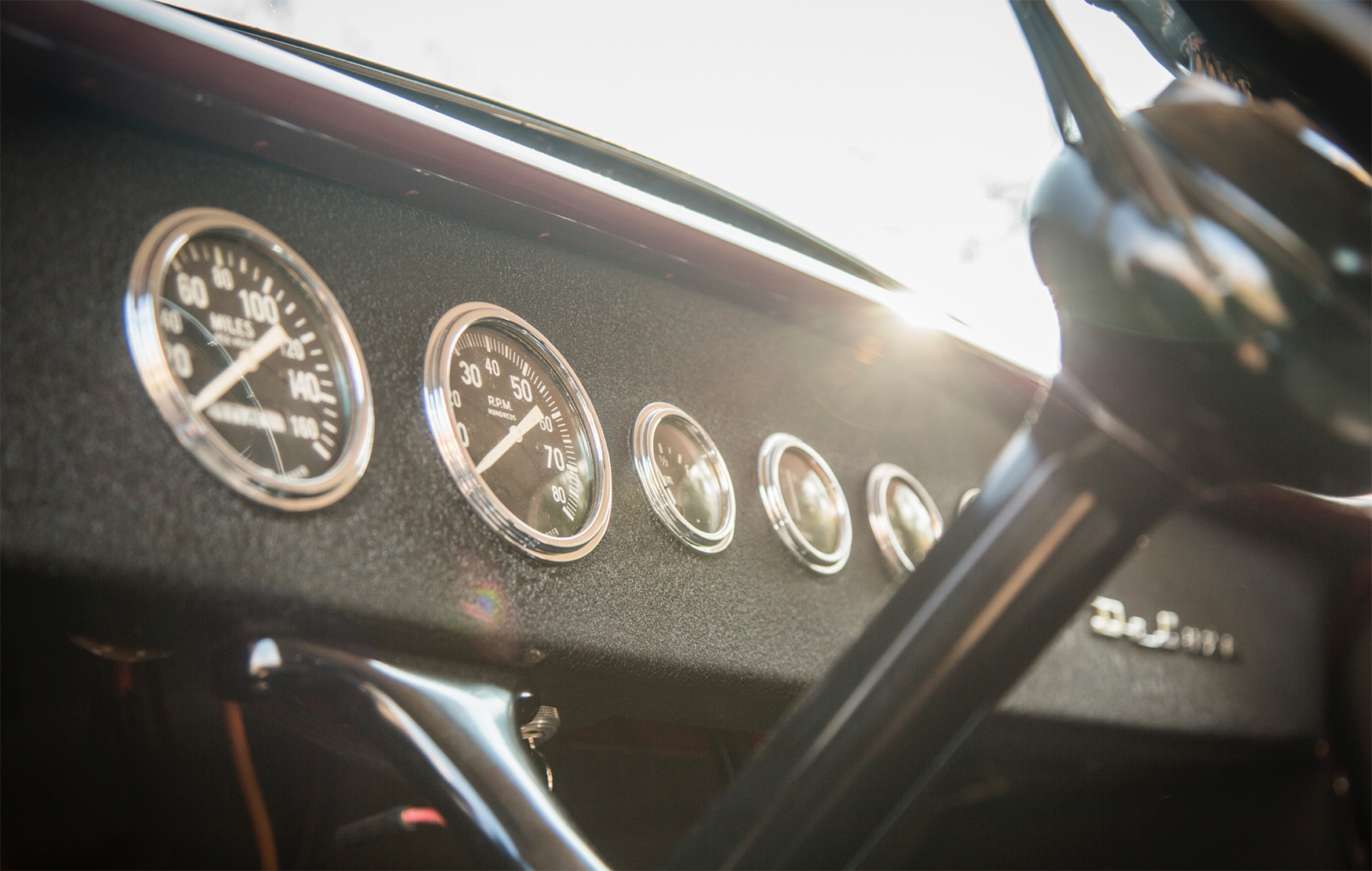
Frequently Asked Questions
Find answers to common questions about Stewart-Warner products

Find answers to common questions about Stewart-Warner products
Since Stewart-Warner has made a lot of instruments since 1905, we are frequently presented with old instruments that the owner wants to the age.
We located a drawing from 1930 where the date codes were specified up through the year 2000. The method of date coding was changed in 1994 to a 2-digit year and 2-digit month. We have combined the two documents here to help you determine the date of manufacture.
| Years | Months | ||||||||||||
|---|---|---|---|---|---|---|---|---|---|---|---|---|---|
| A- | 1909 | A- | 1933 | A- | 1957 | A- | 1981 | 05- | 2005 | 1- | January | ||
| B- | 1910 | B- | 1934 | B- | 1958 | B- | 1982 | 06- | 2006 | 2- | February | ||
| C- | 1911 | C- | 1935 | C- | 1959 | C- | 1983 | 07- | 2007 | 3- | March | ||
| D- | 1912 | D- | 1936 | D- | 1960 | D- | 1984 | 08- | 2008 | 4- | April | ||
| E- | 1913 | E- | 1937 | E- | 1961 | E- | 1985 | 09- | 2009 | 5- | May | ||
| F- | 1914 | F- | 1938 | F- | 1962 | F- | 1986 | 10- | 2010 | 6- | June | ||
| G- | 1915 | G- | 1939 | G- | 1963 | G- | 1987 | 11- | 2011 | 7- | July | ||
| H- | 1916 | H- | 1940 | H- | 1964 | H- | 1988 | 12- | 2012 | 8- | August | ||
| J- | 1917 | J- | 1941 | J- | 1965 | J- | 1989 | 13- | 2013 | 9- | September | ||
| K- | 1918 | K- | 1942 | K- | 1966 | K- | 1990 | 14- | 2014 | 10- | October | ||
| L- | 1919 | L- | 1943 | L- | 1967 | L- | 1991 | 15- | 2015 | 11- | November | ||
| M- | 1920 | M- | 1944 | M- | 1968 | M- | 1992 | 16- | 2016 | 12- | December | ||
| N- | 1921 | N- | 1945 | N- | 1969 | P- | 1993 | 17- | 2017 | ||||
| P- | 1922 | P- | 1946 | P- | 1970 | R- or 94 | 1994 | 18- | 2018 | ||||
| Q- | 1923 | Q- | 1947 | Q- | 1971 | S- or 95 | 1995 | 19- | 2019 | ||||
| R- | 1924 | R- | 1948 | R- | 1972 | T- or 96 | 1996 | 20- | 2020 | ||||
| S- | 1925 | S- | 1949 | S- | 1973 | 97- | 1997 | 21- | 2021 | ||||
| T- | 1926 | T- | 1950 | T- | 1974 | 98- | 1998 | 22- | 2022 | ||||
| U- | 1927 | U- | 1951 | U- | 1975 | 99- | 1999 | 23- | 2023 | ||||
| V- | 1928 | V- | 1952 | V- | 1976 | 00- | 2000 | 24- | 2024 | ||||
| W- | 1929 | W- | 1953 | W- | 1977 | 01 | 2001 | 25- | 2025 | ||||
| X- | 1930 | X- | 1954 | X- | 1978 | 02- | 2002 | 26- | 2026 | ||||
| Y- | 1931 | Y- | 1955 | Y- | 1979 | 03- | 2003 | 27- | 2027 | ||||
| Z- | 1932 | Z- | 1956 | Z- | 1980 | 04- | 2004 | 28- | 2028 | ||||
Note: During the changeover period around 1994-96, both systems were used.
Note: From 1994 and o, a zero was used in front of he months with only a single digit (e.g., 1-January became 01)
For those who are unfamiliar with the part number and date coding we will provide two examples below.
Pre-1994 example:
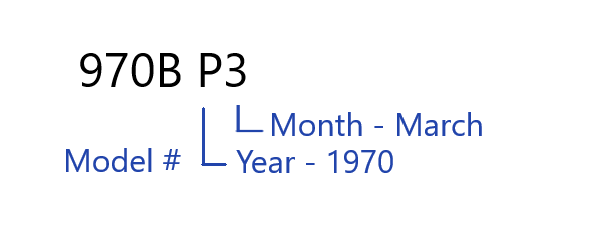
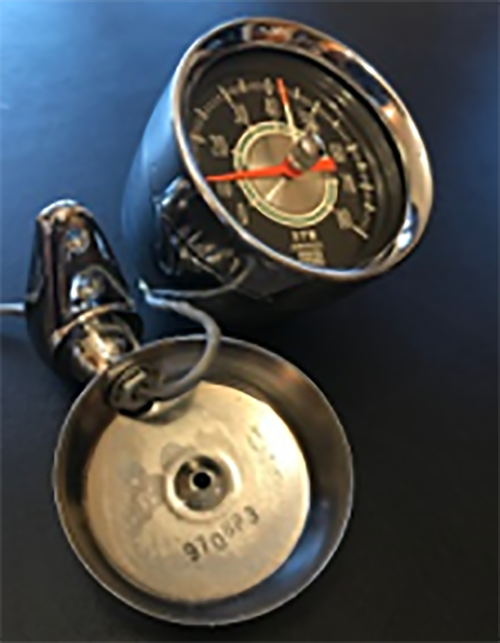
Post-1994 example:
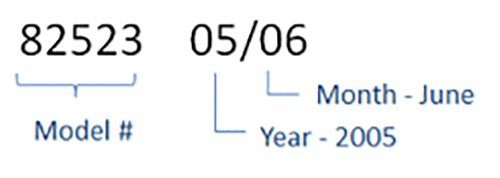
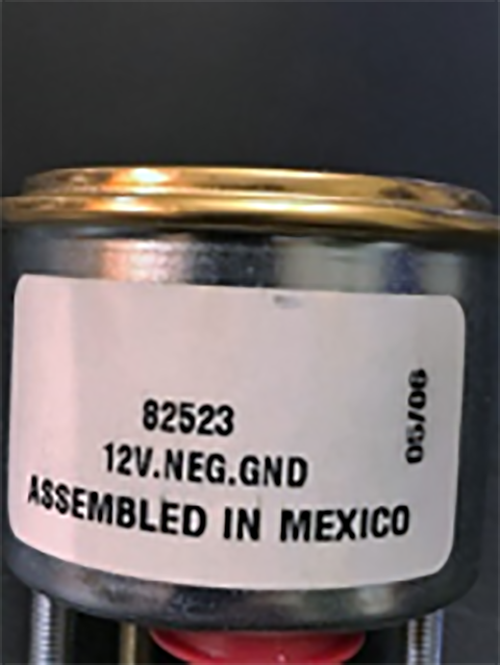
Pressure Systems:
Both gauge and sender must have the same resistance to be a perfect match so that the gauge displays the proper readings. If absolutely required, a different brand pressure gauge or sender with the same stated match could be used until the proper sender. It is not recommended to rely on this set up for any critical system on your vehicle.
Fuel Level System:
Both the fuel level gauge and sender must have the same resistance to function correctly and both should be at the same ground potential.
Fuel level is probably the one gauge/sender combination that mixing brands will generally work if the correct electrical match is used. So, if you already have a fuel sender in your vehicle, you can measure the senders resistance and usually find a compatible fuel level gauge.
Temperature System:
This is the most difficult system to match between manufacturers and Stewart-Warner strongly recommend that you do not mix different brands in a temperature gauge/sender setup.
Most temperature gauges are designed to work with one sender. Each sender has an electrical element with its own characteristics. It is very difficult to find another manufacturer whose gauge dial angles will match the sender’s resistance/temperature curve.
Stewart-Warner speedometers and tachometers have reverse polarity protection. Under normal circumstances our gauges can be mis-wired without being permanently damaged.
Ammeters that require shunt resistors must be wired correctly or the ammeter will be shorted instantly.
Stewart-Warner no longer offers a repair program. Most speedometer shops in your area should be qualified to repair and calibrate instruments.
As a rule of thumb, you can figure that 0.5 amps per instrument. This would include instrument and light kit that came with the instrument. So, for example, if you are installing one our 6-gauge kits, you would utilize a 3-amp fuse.
Unfortunately, at this time we are only able to ship to the lower 48 US states. We do have some dealers with the ability to ship internationally. Check out our Dealer Locator page for more information
Please reach out to Stewart-Warner customer service to receive information on the return process. Customer Service can be reached at info@stewartwarner.com and 800-676-1837
The answer would be: Please reach out to Stewart-Warner customer service to process the return and then you will need to place a new order separately. Customer Service can be reached at info@stewartwarner.com and 800-676-1837
If you purchased directly from our Stewart-Warner website, you will receive an order confirmation via email upon placing your order. You will receive a separate shipment confirmation with a tracking number when the order ships.
Please contact the dealer that you purchased from for any returns.
If you purchased directly from our Stewart-Warner website, you can return any new or unused part in its original packaging within 90 days.To begin your return, please call customer service at1-800-676-1837, or via email customer.service@maximatecc.com. Make sure to have your order number available.
When shipping your item back, you must include your order confirmation as a receipt to be able to process the return. You will be responsible for the cost of shipping the item back.
Once the item is received and processed, your refund will be put back to the original form of payment used for the order.
We are unable to exchange products. You must submit the original item as a return and submit new order for the desired item separately.
Stewart-Warner warrants to the consumers that its instrument products will be free from defects in material and workmanship for a period of 24 months following data of purchase.
If the product fails within this period, please contact the dealer that you purchased from for warranty and replacement consideration.
If you purchased directly from our Stewart-Warner website, please call customer service at1-800-676-1837, or via email customer.service@maximatecc.com. Make sure to have your order number available.
When shipping your item back, you must include your order confirmation as a receipt to be able to process the return. You will be responsible for the cost of shipping the item back.Once the item is received and processed, your refund will be put back to the original form of payment used for the order. Please note, we are unable to exchange products, even if it is defective. You must submit the original item as a return and submit new order for the desired item separately.
Please contact the dealer that you purchased from for warranty and replacement consideration.
If you purchased directly from our Stewart-Warner website, you can return any new or unused part in its original packaging within 90 days.Please call customer service at1-800-676-1837, or via email customer.service@maximatecc.com. Make sure to have your order number available.
When shipping your item back, you must include your order confirmation as a receipt to be able to process the return. You will be responsible for the cost of shipping the item back.
Once the item is received and processed, your refund will be put back to the original form of payment used for the order. Please note, we are unable to exchange products, even if it is defective. You must submit the original item as a return and submit new order for the desired item separately.
Please contact the dealer that you purchased from for warranty and replacement consideration.
If you purchased directly from our Stewart-Warner website, please call customer service at 1-800-676-1837, or via email customer.service@maximatecc.com. Make sure to have your order number available.
Please note, we are unable to exchange products, even if it is has missing or damaged parts. You must submit the original item as a return and submit new order for the desired item separately.
Once a return is received it will take a few days to process your refund, and will depend on the type of return you are doing. Average timing is approximately 7-10 business days.
Within your account, please complete our online tax-exemption process. This must be done and confirmed before adding products to your cart. Once your tax-exempt status is confirmed, you can begin your shopping experience. When logged in for future visits, the certificate will be applied automatically. We are unable to refund tax after an order is complete unless it is for a return.
Once the order has been submitted you are not able to update the delivery address within your account. If an updated is needed, please reach out to Stewart-Warner customer service to see what is possible at 1-800-676-1837 or info@stewartwarner.com.
At the heart of every Stewart-Warner electrical gauge is our high-performance, patented air-core movement – the gauge’s motor. Looking inside the motor reveals two coils (A” & B”) comprised of copper wire wrapped around the front bobbin and a rear bobbin assembly that contains a magnetized armature assembly (magnet & shaft), surrounded by damping fluid which acts to minimize pointer flutter and ensure smooth response.
The bobbin assembly is packaged in a metal isolation can that supports the gauges dial (and light pipe where appropriate), and that can is mounted inside a housing (case). The armature assembly freely rotates within the coils, aligning with the varying magnetic fields produced by the amount of current flowing through the coils. (Current variance is triggered by signals provided by the sender.) The pointer- attached to the shaft on the armature assembly- once calibrated, will provide a directional indication regarding the amount of pressure, temperature, appropriate level of fuel, or voltage being measured.
Senders that drive Stewart-Warner electrical gauges are based on variable resistance technology. The three basic variable resistance senders are temperature, pressure, and fuel level. Each sender possesses a different rate of resistance change, or MATCH, for the specific gauge’s electrical design. The sender’s resistance change results in current changes within the sender’s gauge circuit. These changes cause an increase or decrease in the gauge’s magnetic field. The variance in the magnetic field causes the pointer movement.
Stewart-Warner mechanical gauges include integral bourdon tubes which have one free-floating end that is linked to a gear and shaft assembly, with pressure pulsation and vibration dampening to reduce pointer fluctuations. The bourdon tube can be fine-tuned by varying its strength and stiffness. It works by being deflected (moved) by the pressure of the liquid/gas that is being measured, and it then moves the gear and shaft assembly. In turn, the pointer moves to produce an accurate reading on your dial.
Mechanical pressure gauges have a port on the back to make a direct connection, either through hose or tubing, with the fluid or gas being measured. Mechanical temperature gauges have a sealed capillary tube and bulb assembly, which is filled with temperature sensitive liquid. This liquid produces a proportional vapor pressure when it is exposed to temperature variation. The vapor pressure is the acting force on the bourdon tube and is calibrated to provide accurate pointer movement in relation to the temperature.
Whether the pointer returns to zero depends on if your instrument is mechanical or electric.
Electric:
The pointer not returning to zero on electric gauges, tachometers, and speedometers is NOT a malfunction! As soon as power is supplied to the instrument, the pointer will move to the correct reading.
The pointer no returning to zero is a normal property of the air-core movement inside the gauge. When the electric current is shut off, due to the engine shut down, there is no longer a signal for the gauge to read and the pointer just finds a random place to rest on the dial.t
Mechanical:
Pointers on the mechanical gauges should always return to zero or move to the lowest reading on the dial after the engine has been shut off and settles.
Since Stewart-Warner mechanical gauges have Bourdon tubes that are physically manipulated by the pressure or temperature each is monitoring, the pointer returning to zero could take time as the temperature or pressure dissipates.
The dial range you choose should be based on your vehicles normal operating characteristics. During normal operation, your gauge should be at or close to the center of this range.
Range too narrow
You do not want to use a gauge that has a maximum reading that is the same as or close to your normal operating range. This will not allow you to see if what you are monitoring goes above its intended range of operations.
Example:
If your vehicle is set to run at 15lbs boost, you do not want to use a 15PSI boost gauge. It will not allow you to monitor the high range in case of over-boost.
Range too broad
You also do not want to select a gauge that has too large of a range. In this case you may lose resolution (readability) for the range that you wish to monitor.
Example:
If your oil pressure should be at 30 PSI, a 5 PSI drop in pressure may be critical to identify. If you were to use a 150 PSI gauge, that 5 PSI drop may go unnoticed. However, if you were to use a 100PSI gauge you would have greater resolution and would notice the drop in pressure.
A voltmeter measures electrical potential (pressure) in units called volts that is necessary for current measured in amps (a quantity) to flow through your electrical system. If there is no pressure (volts), there can be no current flow (amps). This is analogous to having no oil pressure, and therefore, no oil flow. One must have one to get the other.
Ammeters were popular when generators and alternators typically averaged 35-40 amps of output, and vehicle electrical systems were much less complex. Today, alternators commonly have output capacities of 100-110 amps with more complex wiring and higher accessory loads. This makes it more difficult to install an ammeter. Just as we measure oil pressure rather than oil flow, we prefer to measure volts rather than amps. So, the overwhelming choice for performance applications today is the voltmeter.
The bottom-line… an ammeter is NOT an effective solution for today’s applications.
Restorers often prefer to use ammeters if that was the type of gauge originally in the vehicle which is why we offer both voltmeters and ammeters.
This one has an easy answer. Since a diesel-powered vehicle does not go into Vacuum, you would use a straight Boost gauge. For a gasoline powered vehicle, you would use a Vac/Boost gauge since you will have a vacuum in your intake manifold when the throttle closes. This will also help to determine if you have a vacuum leak which could lead to problems.
For safety reasons it is not permitted to use a mechanical Fuel pressure gauge inside you vehicle unless you are using a fuel pressure isolator on the engine side of the firewall.
No, you cannot alter the length of the tubing. You can however coil it making sure not to kink the line. A kinked line will cause the gauge to be inoperable or respond very slowly. Coiling it in a 2” or larger diameter is acceptable.
The “Revolution” refers to one full turn of the crankshaft. The “Pulses” refer to an electrical pulse created on the coil signal/control wire every time the coil fires the plug. The number of pulses created on the signal/control wire for each revolution depends on the ignition system
This depends on your ignition system. Below is the different types and the PPR setting for each type.
1 Coil for all plugs.
On a distributor ignition system, the rotor turns at half the speed of the crank shaft. With this type of system, you would divide the number of cylinders by two to determine the PPR.
Example: a tach on 4-cylinder engine would be set to 2 PPR.
As the distributor rotates there are four positions where the coil fires and as the rotor reaches each point in turn, the spark plug for that position is fired. Since the rotor is turning at half the speed of the crankshaft, only two plugs are fired (creating two pulses), during on full revolution of the crankshaft. Thus, 2 pulses per revolution on a 4-cylinder (2 PPR).
A 6-cylinder would have 3 pulses per revolution; an 8 cylinder would have 4 pulses, etc…
Although not always available, it is most desirable to connect to the tach signal wire from the ECU to the factory instrument cluster. The PPR setting for this connection is usually the number of cylinders divided by 2. A 4-cylinder engine would be set to 2 PPR, a 6-cylinder engine to 3 PPR, etc.
1 Coil for all plugs.
One these systems, one coil ignites two spark plugs at the same time. Your PPR setting will always be 1 PPR when connecting to one of the coil trigger wires.
1 Coil On Plug.
There is one signal/control wire for each coil/spark plug. When connecting to any one of these signal/control wires, your PPR setting will always be 0.5.
NOTE: Some manufacturers “multi-spark” the plugs for better emissions control.
If your ECU multi-sparks, the RPM display on the tach may be erratic or high. In this case, the signal/control wire can not be used for the tachometer signal.
You will need to connect to the signal wire from the ECU/Ignition Module that feeds the factor tachometer (if available). The PPR setting is generally half the number of cylinders.
Not all vehicles have a factory tachometer wire and in this case the use of a tach adapter is required.
You can add a simple filter by acquiring a resistor and capacitor from an electronics retailer. The resistor should be 1000 ohms or reasonably close to that +/- 10% with a ½ watt or higher rating. This will generally take care of this condition. However also adding a .1 uF capacitor with 25 volt or higher rating can improve it more if the resistor by itself did not completely resolve it. If the capacitor is used, some have polarity, so make sure you put the + lead on the signal stud and the – lead on the ground stud of the Tach. Please refer to diagram below.
Stewart-Warner no longer manufactures speedometer cables however you can purchase from Speedometer Service and Instrument Company. They can be reached at (503) 227-5567.
Yes, the Tachometer filter that corrects the erratic condition on a Tachometer will in most cases also fix the erratic condition in a Speedo.
Most senders operate one gauge. Stewart-Warner has developed temperature and pressure senders to operate 2 gauges.
| Type | Range | Catalog ID |
|---|---|---|
| Pressure | 0-80 PSI | 82514 |
| 0-100 PSI | 82501 | |
| Temperature | 100° – 230°F | 82503 |
Stewart-Warner makes a variety of adjustable fuel tank senders for a multitude of applications.
Fuel senders must match the resistance range (measured in ohms) of the gauge. The following are examples of the resistance ranges of gauges and senders:
All Stewart-Warner fuel senders meet the SAE standard for five bolt flange pattern.
Stewart-Warner does not make a direct replacement fuel sender for an automotive OEM application.
If you are not sure of the fuel sender’s resistance, determine it by following this method:
Stewart-Warner offers several adjustable fuel tank senders so that you can select the correct unit to fit your application.
For Shallow Tanks:
For Deeper Tanks:
Use the chart below to determine:
| Pressure (Dial) Range | S-W Sender Part Number |
|---|---|
| 0-16 PSI | 02504-F |
| 0-60 PSI | 279D |
| 0-80 PSI | 279A |
| 0-100 PSI | 279B-F |
| 0-150 PSI | 279C |
| 0-80 PSI dual guage | 82514 |
| 0-100 PSA dual guage | 82501 |
Use the chart below to determine:
| Guage Style | Temperature (Dial) Range | S-W Sender Part Number |
|---|---|---|
| Deluxe, Greenline | 60 – 240°F; 100 – 240° F | 280EA |
| Heavy-Duty, Wings, HD+, Power Series | 100° – 230°F; 100° – 240°F | 280EC |
| Deluxe, Muscle, Heavy-Duty, Catalina, Mariner, Aviator, Forged Carbon | 100° – 280°F | 280ED-F |
| Deluxe, HD+, Wings | 140° – 320°F | 280EE-F |
A 3-wire sensor is recommended for Speedometer applications as it will provide a strong signal when the Vehicle is moving slowly or at a complete stop. Stewart-Warner P/N 82623B is our recommended sensor. We also recommend our GPS sensor P/N 988P for an even easier installation.
We're always here to help